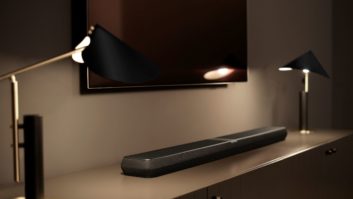While technology companies in every segment must concern themselves with specifications, capabilities, new features, and upgrades, for custom installers thats just half the battle. Most will attest that what really matters is that you can deliver a working product, on time, at a reasonable price.
What dealers are selling is their ability to interact with a client, design, and install a system that is going to meet the individual needs of each client. They are very service-oriented and very market-oriented in terms of reaching the target for their customers and meeting the needs of each one, individually, said Jeanne Stiernberg, principal consultant at Stiernberg Consulting in Sherman Oaks, California. Custom electronics dealers are selling their own professionalism, and that is what they expect, too.
This has led custom installers to re-examine their relationships with manufacturers. There is less of an emphasis on the brands of gear that they carry, and more emphasis on the brand of the dealership, Stiernberg observed. Certainly they carry great brands and they stand behind them and thats importantbut they are getting away from the box-house, retail mentality where you focus on the brand and the price.
Which requires that attention is paid to something that is, presumably, a little less sexy in the minds of technophiles: the implementation of an effective product purchasing process. There is an emphasis towards choosing supplierswho still must have good productsfor the business relationship that they have with them, Stiernberg said. What manufacturers are starting to understand is that dealers need and want a good business partner in their suppliers. They are looking at factors such as terms, freight policy, warranty, customer service, technical service, order tracking and the things that make them more efficient. The leading-edge manufacturers are getting it and putting programs into place to address that.
As the industry is evolving, the relationship between dealers and manufacturers is becoming more collaborative, Stiernberg noted. Dealers need to approach suppliers as business partners and explain that they are looking for a long-term relationship, she said. Many manufacturers offer prompt pay terms. Many manufacturers will also offer floor-plan financing of demos. Many dealers dont have showrooms, but manufacturers that make really expensive, high-end gear, will oftentimes help the dealer finance getting the demos to help them sell. Its another part of being a partner with the dealers.
By developing and nurturing a partnership, custom installers better position themselves to get the best deal. When a dealer sits down with a manufacturer and the dealers own strategic plan, right away that puts them in the top five to 10 percent of all the dealers out there, Stiernberg said. A manufacturer is more likely to pay attention to that. Its more respectable and its more considered.
This also helps to promote compromise; dealers that present themselves as organized are less likely to be strong-armed into buying a lot of product that they dont need. If this happens anyway, however, it might be necessary to break the relationship. We have walked away from product lines that have done that, only to have them come back and tell us that they have changed their policy, recalled Steve Hayes of Custom Electronics, Inc. in Falmouth, Maine.
In the quest for the best relationship, an increasing number of custom installation companies are turning to distribution outlets. More and more distributors are entering the market by way of rep firms. Many rep firms are setting up a distribution arm as well, Stiernberg pointed out. There are huge advantages here for dealers: first of all, dealers dont have to hold as much inventory because they can get their goods quickly from distributors. They also then have a sales and marketing partner that is geographically focused. The other thing is that some distributors offer a lot of support services such as training and procurement management.
Such is the case for Stanislaus Audio Video Inc., a Modesto, California-based commercial systems integration firm with some experience in the residential field. There are two things that we consider: do we need to deal directly with a manufacturer, or would we be better served by a distributor? explained George Turner, the companys president. Some distributors provide a very high level of service not just in delivering the product, but in after-sales support and training. You have to really determine what you are going to get for the dollars that you spend besides just the product.
Once dealers have narrowed their options, its time to do some asking around. If you are intending to hang your hat on a product line and make a commitment to a manufacturer, you need to do your research, Turner advised. You need to find out from other dealersand they are certainly easy to find, and they dont need to be in your areawhat the manufacturer does when you have a problem. Do they support you if you need something repaired or exchanged? Do they have a direct representative that calls on you, or must you deal directly with someone somewhere else, which is much more difficult? Do your homework, know what you are getting into, and look for the proof before you eat the pie.
Like many of the clients they service, dealers are also beginning to adopt a one-stop shop approach, where they obtain as many items as they can from as few suppliers as possible. Historically, dealers had a the more, the merrier mentality about how many different brands that they represented. The emphasis was on selling the brands to the customers, and they were also kind of enamored by the gear itself – thats why many dealers got into this business in the beginning, Stiernberg reflected. Now they are starting to thin the herd and narrow it down to fewer brands that they carry so that they have deeper relationships with fewer suppliers. That way, they have fewer suppliers to track when it comes to purchasing and paying invoices. And, they get better terms.
When considering a supplier, Hayes and his team examine consistency. What we really look for is how predictable the manufacturer is, he explained. Frankly, what gadgets and what is cool about the product doesnt really matter. Clients dont care. What I really want to know from that manufacturer is that when I say, I want Part A, is it going to be available? Is the pricing going to be there? Are the margins going to be there, and if it breaks or shows up broken, can I get it fixed right away? It really has to do with the performance of the manufacturer; not the bells and whistles of the product.
This is especially important considering that many manufacturers serving the custom installation market are relatively small, boasting limited resources. The biggest issue that we have is predictability of the manufacturers: what product do they have in place, and when can they get it to us, and is this month like last month? Hayes noted. Often, it isnt. Many manufacturers in this industry are small manufacturers, so they dont have purchasing power, which means they may not have the stock. Sometimes we get burned: when it should be here, the manufacturer doesnt have it.
While the technology that they integrate into homes advances on a daily basis, so, too, is the back-office technology that custom installation companies are using to track orders. Another trend is electronic ordering and freight monitoring. This increases the dealers efficiency, too, Stiernberg said. If they are able to order their products online, pretty much 24/7, and then watch and monitor freight, they can be more efficient in terms of just-in-time ordering.
Along with this is the willingness of some organizations to be flexible with delivery. More manufacturers are understanding that dealers need the good drop-shipped to different locations, Stiernberg said. With drop-shipping or any kind of shipping or ordering, if that manufacturer or distributor also has electronic ordering and freight monitoring, the dealer can see where their goods are going, and when they are going to arrive. It increases efficiency, and they can send their crews out to install the equipment, and know that it will be there.
Hayes goes even further: I would love it if manufacturers would have all of their inventory and production schedule online so that I can look at what they have available so that I can specify and order, electronically, and assure delivery, he said. I already have software on my end that would allow me to send them the data that outlines what we have specified, and what we will likely sell over the next six months. That would allow them to purchase the raw goods to build what I am likely going to sell.
Carolyn Heinze ([email protected]) is a freelance writer/editor.






